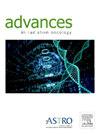一种用于术中近距离放射治疗的新型单向永久装置的前瞻性评价
IF 2.7
Q3 ONCOLOGY
引用次数: 0
摘要
CivaSheet是一种新型的辐射输送装置,由嵌入生物可吸收聚合物片的单向屏蔽Pd-103源组成。这有助于术中在手术肿瘤床上放置永久近距离治疗种子,同时最大限度地减少对覆盖结构的剂量。目前尚未公布该设备的临床试验数据。我们前瞻性地研究了其作为标准术中放射治疗(IORT)替代方案的可行性。方法和材料:这是一项前瞻性研究,研究对象为有IORT指征的腹腔恶性肿瘤手术患者。先前的外部光束辐射是允许的。主要终点是可行性,定义为10例患者中有7例在技术上满意地放置了CivaSheet。次要终点是不良事件、局部控制和种植体稳定性。结果10例患者入组并行手术治疗。8例患者成功植入CivaSheet。根据术中对肿瘤床结构的评估,2例排除的可行性在技术上是不利的。所有植入患者均接受盆腔侧壁或骶前间隙治疗,处方中位剂量为100 Gy。自植入之日起的中位随访时间为25个月。1例患者种植后3个月边缘复发,1例患者种植后13个月部位复发。1年和2年的当地控制率分别为86%和69%。未观察到与器械相关的4-5级不良事件。所有患者的移植后稳定性均令人满意。这是首次发表的一种新型单向近距离治疗装置的临床试验。事实证明,CivaSheet是一种可行的技术,可为手术切除后高危盆腔恶性肿瘤患者提供术中放疗,值得进一步研究和临床考虑,特别是在没有其他IORT选择的情况下。本文章由计算机程序翻译,如有差异,请以英文原文为准。
Prospective Evaluation of a Novel Unidirectional Permanent Device for Intraoperative Brachytherapy
Purpose
The CivaSheet is a novel radiation delivery device consisting of unidirectionally shielded Pd-103 sources embedded in a bioabsorbable polymer sheet. This facilitates intraoperative placement of permanent brachytherapy seeds in a surgical tumor bed, while minimizing dose to overlying structures. No clinical trial data have yet been published for this device. We prospectively investigated its feasibility as an alternative to standard intraoperative radiation therapy (IORT).
Methods and Materials
This was a prospective study in patients with abdomopelvic malignancies undergoing surgery with an indication for IORT. Prior external beam radiation was allowed. The primary endpoint was feasibility, defined as technically satisfactory placement of CivaSheet in ≥7 of 10 patients. Secondary endpoints were adverse events, local control, and implant stability.
Results
Ten patients were enrolled and underwent surgery. Eight patients successfully underwent CivaSheet implantation. The 2 feasibility exclusions were technically unfavorable based on intraoperative assessment of tumor bed configuration. All implanted patients were treated to the pelvic sidewall or presacral space with a median prescription dose of 100 Gy. Median follow-up from the date of implant was 25 months. One patient had a marginal recurrence 3 months after implant, and 1 patient recurred at implant site after 13 months. One and 2-year estimates of local control were 86% and 69%, respectively. No device-related grade 4-5 adverse events were observed. Postimplant stability was deemed satisfactory in all patients.
Conclusions
This is the first published clinical trial of a novel unidirectional brachytherapy device. CivaSheet proved to be a feasible technique to deliver intraoperative radiation to patients with high-risk pelvic malignancies after surgical resection, and warrants further study and clinical consideration, particularly in settings where other IORT options are not available.
求助全文
通过发布文献求助,成功后即可免费获取论文全文。
去求助
来源期刊

Advances in Radiation Oncology
Medicine-Radiology, Nuclear Medicine and Imaging
CiteScore
4.60
自引率
4.30%
发文量
208
审稿时长
98 days
期刊介绍:
The purpose of Advances is to provide information for clinicians who use radiation therapy by publishing: Clinical trial reports and reanalyses. Basic science original reports. Manuscripts examining health services research, comparative and cost effectiveness research, and systematic reviews. Case reports documenting unusual problems and solutions. High quality multi and single institutional series, as well as other novel retrospective hypothesis generating series. Timely critical reviews on important topics in radiation oncology, such as side effects. Articles reporting the natural history of disease and patterns of failure, particularly as they relate to treatment volume delineation. Articles on safety and quality in radiation therapy. Essays on clinical experience. Articles on practice transformation in radiation oncology, in particular: Aspects of health policy that may impact the future practice of radiation oncology. How information technology, such as data analytics and systems innovations, will change radiation oncology practice. Articles on imaging as they relate to radiation therapy treatment.
 求助内容:
求助内容: 应助结果提醒方式:
应助结果提醒方式:


